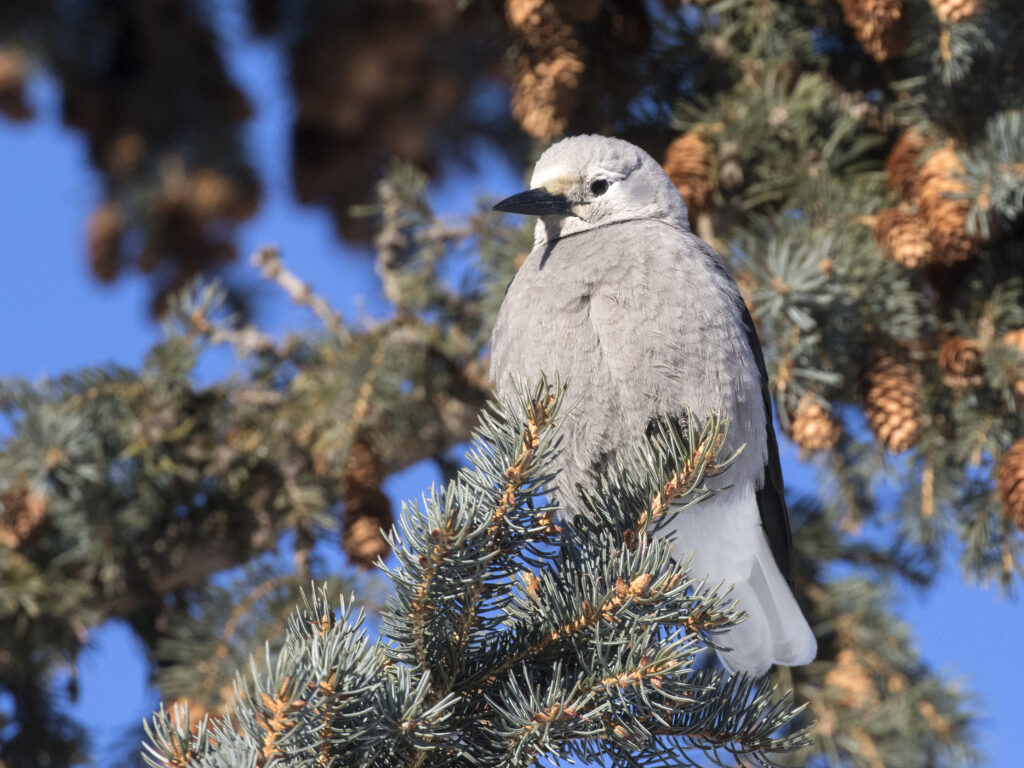Clark’s Nutcrackers: Last call for Whitebark Pines?

When you hear the words “whitebark pine”, what images come to mind? For many, hearing the name of this iconic tree evokes a sense of remote wilderness, the hush of alpine solitude, or the whispering of wind along a rocky treeline. But if you’ve spent time among groves of whitebark pines, your thoughts may also run to the raucous cries of the gregarious Clark’s Nutcracker.
Whitebark pine rely heavily on Clark’s Nutcrackers for seed dispersal. The seeds form in tough female cones that do not open without mechanical force applied from the outside. Clark’s Nutcrackers have strong, sharp bills which they use to pry apart the cone scales and break through to seeds. Because whitebark pine is a masting species, in some years it produces a preponderance of cones, overwhelming the abilities of would-be seed predators to immediately consume the entire seed crop. During masting events, Clark’s Nutcrackers stash excess seeds in caches throughout the birds’ home ranges, often miles away from parent trees. This strategy has been so successful for the Clark’s Nutcracker that it has evolved a sublingual pouch for seed-transport, as well an incredible spatial memory—giving the bird the ability to cache and remember the locations of tens of thousands of seeds, far more than can be eaten in a single year. This spells good news for whitebark pines; seeds which are forgotten or abandoned in favorable microsites then have the chance to germinate.

Clark’s Nutcracker. Photo by Bob Martinka.
However, this relationship is not equal. Although whitebark pines are heavily dependent upon Clark’s Nutcrackers for seed dispersal, the birds can also feed upon seeds of other tree species. When whitebark pine stands decline below a certain threshold of cone-bearing trees, Clark’s Nutcrackers may abandon the stands altogether.
Vlad Kovalenko, who recently completed his M.S. degree in the University of Montana’s System Ecology program, has spent the past several years studying the decline of whitebark pine. The tree was recently federally listed as threatened, primarily due to the fungal disease known as white pine blister rust. This typically-fatal disease, combined with other environmental factors such as climate change and pine beetle outbreaks, has caused steep declines across much of whitebark pine’s range. In Glacier National Park, for example, approximately 70% of whitebark pines have already died from blister rust, and the majority of remaining trees show signs of infection. The disappearance of whitebark pine on the landscape would be a loss to many different living organisms. A keystone species, whitebark pine is considered essential for maintaining biodiversity in subalpine and treeline ecosystems. The tree also provides valuable ecosystem services, such as slowing runoff from snowmelt and reducing soil erosion.
Vlad’s work focuses on understanding the drivers of whitebark pine infection, mortality, cone production, and regeneration in Glacier National Park, as well as how these factors influence Clark’s Nutcrackers’ home range and habitat use. Vlad has found that whitebark pine is more likely to be infected by blister rust in the southern and eastern portions of Glacier, at lower elevations, and in places with higher relative humidity in the springtime. Conversely, whitebark pine seems to be doing better at higher elevations and places where there is more snow accumulation in late summer, when blister rust is typically passed to whitebark from plants in the genus Ribes, the fungus’ alternate hosts. If snow is currently serving as a barrier to the spread of the spores, then as climate change is causing shifts in precipitation from snow to rain, in the future it’s likely the seasonal effect will be lost, because rust spreads very well when leaves are wet and humidity is high.
Using occupancy modeling, Vlad has found that Clark’s Nutcracker habitat use is highly dependent on cone production, and that the birds seem to key in on mature whitebark stands, where cones are produced. However, Vlad notes that, because mature trees are also more likely to be infected by rust, cone production is at risk. Without an adequate cone crop, Clark’s Nutcrackers may stop returning to many of Glacier’s stands.
In the face of climate change, what can humans do to help? In addition to studying many other factors that contribute to whitebark pine’s decline, scientists are also planting rust-resistant seedlings at key study sites. Their hope is that the rust-resistant seedlings will eventually naturally propagate, improving whitebark pine survival probability, and keeping the cacophonous call of the Clark’s Nutcracker a resounding part of this ecosystem.
You can learn more Vlad and his research, at the National Park Service and the Glacier National Park Conservancy. And, if you have questions, feel free to drop him an email!
